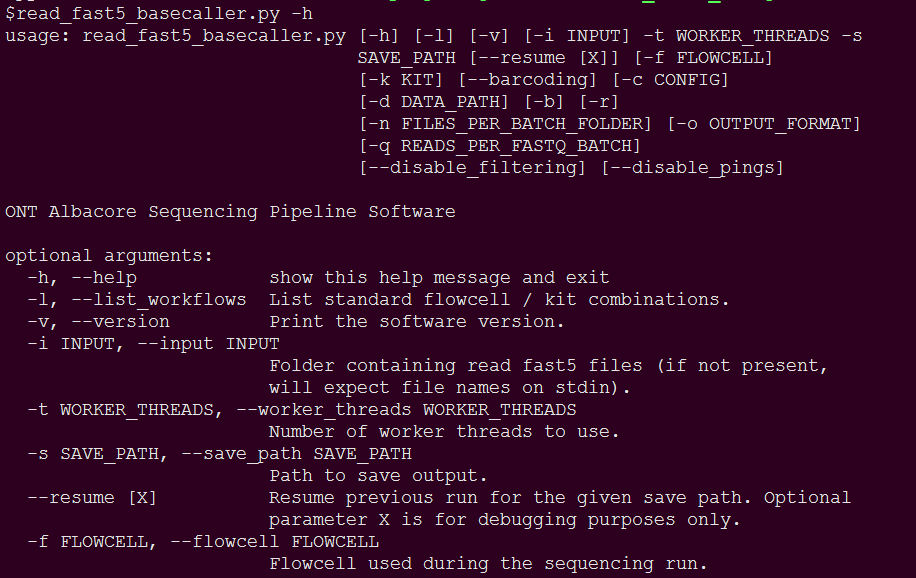使用Nanopore MinION测序,当电脑跟不上时(如果采用笔记本来测,建议价格在1w以上的),测序会断掉。这时如果保留有fast5文件,还可以救——手动basecalling。
目前,做basecalling的软件有ONT官方提供的Albacore,Nanonet,Guppy和Scrappie,以及非官方的Nanocall(已淘汰,仅在早期的文章中看到),DeepNano和Chiron。它们之间的比较可参见[1],另外在人类基因组Nanopore测序文章中也特别比较了Albacore和Scrappie[2]。这些basecalling大多要在不断升级中,各软件间存在一些差异,特别是对poly结构的basecalling。
Albacore集成在MinKNOW,因此测序时可作实时的basecalling,它在文章中出现次数最多,也是目前主要的开发热点。可在nanopore官网下载最新版的Albacore,例如:
wget https://apac.oxfordnanoportal.com/software/analysis/ont_albacore-2.3.1-cp35-cp35m-manylinux1_x86_64.whl
下载下来后,需要python3.5环境,如果有安装conda,则方便可以建立一个python3的环境,在这个环境中作后续分析,具体步骤可查看我的另一篇博文[3],在集群上用以下代码进入python3.5环境
source activate python3
再用以下代码进行安装:
pip3 install ont_albacore-xx.whl
当然conda环境不是必需的,必需的是Python3.5环境。
安装完成后,用以下-h看一下是否安装成功
基本运行代码如下:
read_fast5_basecaller.py --input /path/to/fast5/dir --recursive --worker_threads 10 --flowcell FLO-MIN106 --kit SQK-LSK108 --save_path /path/to/output
注意:FLO-MIN106这个是flowcell的型号,类似FAH57248这个是flowcell唯一的id,这里--flowcell是FLO-MIN106
另外,如果是混合测序,可添加--barcoding选项,程序会自动搜索barcode;如果想个性化的指定参数,可以提供config文件,再通过--config指定。
# --input指定输入的文件夹,配合--recursive选项,可以只指定最上层目录,程序会自动递归寻找其中的fast5文件
# --worker_threads指定线程数
# --kit的只能在https://nanopore.yilimart.com/Group/Kits1/这里选择现有的试剂盒
# --save_path指定输出的目录
运行完后生成configuration.cfg,pipeline.log,sequencing_summary.txt和workspace文件夹,在workspace文件夹中存放有pass和fail文件夹,里边放的是fastq文件,通常用pass目录下的文件作后续分析。
configuration.cfg记录运行参数,默认min_qscore_1d值为7.0,这个值非常重要,因为它和reads过滤为pass/fail有关,后续有详解;另外还记录有fastq相关文件(夹)命令规则:
[fastq]
identifier = {read_id}
header = {identifier} runid={run_id} read={read_number} ch={channel_id} start_time={start_time_utc}
header_with_barcoding = {identifier} runid={run_id} read={read_number} ch={channel_id} start_time={start_time_utc} barcode={barcode_id}
batch_file_name = fastq_runid_{run_id}_{batch_counter}.{extension}
single_file_name = {read_id}.{extension}
all_file_name = fastq_runid_{run_id}.{extension}
sequencing_summary.txt记录的信息最为全面,这也是目前Nanopore QC软件玩花样的竞技场! 其中的19列内容如下:
filename | fast5文件名 |
read_id | 每个fast5文件对应一条read |
run_id | 这次run的id号,一个flowcell通常为一个run,所以sequencing_summary中run_id都一致。如果一个flowcell中途停掉再跑,每跑一次会记录新的run id |
channel | 测序有512个channel,这个记录read在哪个channel测的 |
start_time | 这条read测序起始时间 |
duration | 这条read测序经过时间 |
num_events | event的概念为历史遗存,目前已弃用 |
passes_filtering | read的mean_qscore_template大于7(即min_qscore_1d的默认值)时为True,否则为False |
template_start | template不详,如有知情者欢迎补上! |
num_events_template | |
template_duration | |
num_called_template | |
sequence_length_template | 记录的read的长度 |
mean_qscore_template | pass和fail通过这一项进行划分,注意默认是从0-7(不包括0和7!)等于0的划分为skip,不过通常skip目录不会保留 |
strand_score_template | 这几个值不详 |
calibration_strand_genome_template | |
calibration_strand_identity_template | |
calibration_strand_accuracy_template | |
calibration_strand_speed_bps_template |
注:其中最重要的是mean_qscore_template值
后续分析建议用pass目录下的read进行。
参考材料:
[1] https://github.com/rrwick/Basecalling-comparison
[2] Miten Jain, Sergey Koren, Karen H Miga. et al. Nanopore sequencing and assembly of a human genome with ultra-long reads. nature biotechnology. 2018. doi:10.1038/nbt.4060
[3] http://blog.sciencenet.cn/blog-2970729-1074395.html
转载本文请联系原作者获取授权,同时请注明本文来自卢锐科学网博客。
链接地址:https://wap.sciencenet.cn/blog-2970729-1124496.html?mobile=1
收藏



